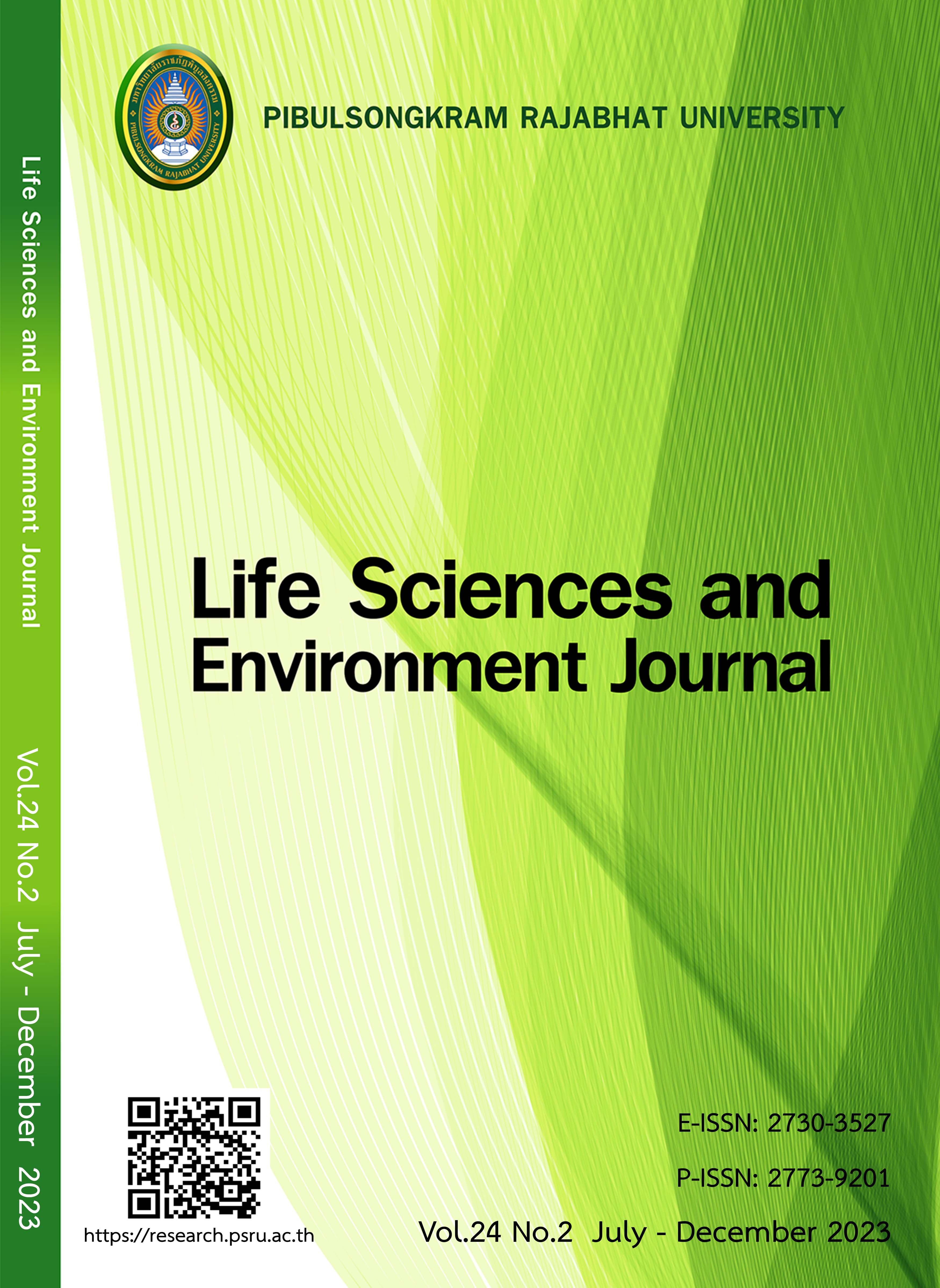EXTRACTION OF CMC FROM CORNCOB AND ITS APPLICATION AS COATING AGENT ON MANGO FRUIT
DOI:
https://doi.org/10.14456/lsej.2023.25Keywords:
Carboxymethyl cellulose, Corncob, Coating agentAbstract
This study aimed to synthesize carboxymethyl cellulose (CMC) from corncobs for use as coating agent on mango. Cellulose is converted by etherification under suitable conditions and then finally purified. Then, the extracted CMC was used as a film for coating the mango fruit. Under the optimized reaction conditions, the extracted CMC had a degree of substitution (DS) of 0.12. The results showed that the FTIR spectra of the obtained CMCs exhibited strong absorption bands in the range of 1600-1700 cm-1, which was related to the carbonyl group (C=O) vibration stretching absorption. The absorption in the 1400–1450 cm-1 region is due to symmetrical deformations of CH2 groups. The strong absorption bands in the range of 1200–1000 cm-1 are due to the stretching vibration of the ether (-O-). The FT-IR results confirmed CMC modification. Thermal analysis found that CMC had a melting temperature in the range of 163.2-181.4 oC. In degradation, CMC can be completely decomposed within 72 hrs using the soil embedding method. The results of the water vapor permeability (WVP) test showed that CMC and glycerol affected the film properties. Increasing CMC content, water vapor permeability (WVP) decreased. In contrast, with increasing glycerol, increased WVP. We conclude that fruits coated with the obtained CMC from corncob could maintain the quality of Nam Dok Mai Mango (Mangifera Indica Linn.).
References
Adetunji CO, Arowora KA, Fawole OB, Adetunji JB, Olagbaju AR. Effect of edible coating of carboxymethyl cellulose and corn starch on cucumber stored at ambient temperature. Asian Journal of Agriculture and Biology 2013;1(3):133-140.
Agriculture and Cooperatives office (Online). Available https://www.opsmoac.go.th/nakhonsawan-dwl-files-441591791095; 2022.
Aytunga AK, Ferhunde U. Starch-cellulose ether films: Microstructure and water resistance. Journal of Food Process Engineering 2017;40:1-8.
Bono A, Ying PH, Yan FY, Muei CL, Sarbatly R, Krishnaiah D. Synthesis and characterization of carboxymethyl cellulose from palm kernel cake. Advances in Natural and Applied Sciences 2009;3(1):5-11.
Elomaa M, Asplund T, Soininen P, Laatikainen R, Peltonen S, Hyvarinen S. Determination of the degree of substitution of acetylated starch by hydrolysis, 1 H NMR and TGA/IR. Carbohydrate Polymers 2004;57:261-267.
Gouhua Z, Ya L, Cuilan F, Min Z, Caiqiong Z, Zongdao C. Water resistance, mechanical properties and biodegradability of methylated cornstarch/poly (vinyl alcohol) blend film. Polymer Degradation and Stability 2006;91(4):703-711.
Hailu A. Production and optimization of carboxymethyl cellulose from waste cartons. Master of Science, Department of Science, University of Addis Ababa; 2016.
Ismail N, Bono A, Valintinus A, Nilus S, Chng L. Optimization of reaction conditions for preparing carboxymethyl cellulose. Journal of Applied Sciences 2010;10:2530-2536.
Kasinee S, Rujira D, Lampan K. Effect of carboxymethyl cellulose as edible coating on postharvest quality of rambutan fruit under ambient temperature. International Journal of Agricultural Technology 2017;13(7.1):1449-1457.
Maftoonazad N, Ramaswamy HS. Postharvest shelf - life extension of avocados using methylcellulose -based coating. LWT. Food Science and Technology 2005;38:617–624.
Nuttawadee J, Jurmkwan S, Sutthira S, Suthaphat K. Properties of carboxymethyl cellulose (CMC) film from rice straw pulp. Journal of Science Agricultural 2012;43(3):616-620.
Pongnoree J, Kongbangkerd T. Preparation of cellulose from corncobs I: Study on cellulose extraction. Songklanakarin Journal of Science Technology 2006;28(1):191-199.
Rachtanapun P, Luangkamin S, Tanprasert K, Suriyatem R. Carboxymethyl cellulose film from durian rind. LWT. Food Science and Technology 2012;48(1):52-58.
Rawiwan P, Atchara J. Development of carboxymethyl cellulose coating combined with galanga extract on postharvest guava presevation. Proceedings of 6 th National Kamphaengphet Rajabhat University 2021; 874-881.
Rudnik E, Briassoulis D. Degradation behaviour of poly (lactic acid) films and fibers in soil under mediterranean field conditions and laboratory simulations testing. Industrial Crops and Products 2011;33(3):648-658.
Sajid A, Muhammad A, Ahmad S, Aamir N, Shaghef E, et al. Carboxymethyl cellulose coating delays ripening of harvested mango fruits by regulating softening enzymes activities. Food Chemistry 2022;380:1-11.
Shui T, Feng S, Chen G, Li A, Yuan Z, et al. Synthesis of sodium carboxymethyl cellulose using bleached cellulose fractioned from cornstalk. Biomass and Bioenergy 2017;105:51-58.
Singh R, Singh A. Optimization of reaction conditions for preparing carboxymethyl cellulose from corn cobic agricultural waste. Waste and Biomass Valorization 2013;4(1):129-137.
Sothornvit R, Krochta J. Plasticizer effect on mechanical properties of β-lactoglobulin films, Journal of food engineering 2001;50:149-155.
Sumitra P. Isolation of cellulose from some plants and synthesis of its derivatives. Master of Science, Department of Science, Chiangmai University; 1980.
Tengrang S, Xenmak P, Liapwan N, Loylert K, Sukhakasem S, Watthanawichit, W., et al. Research and development of packing degradable products from agricultural products. In Research and development package report. Bangkok Office of postharvest and product processing research and development, farmers' products, Agriculture 2015;198.
Tikhamporn C, Benjawan B, Piched A. Carboxymethyl cellulose from corn peel. Kasetsart University, Kamphaengsaen Campus; 2019.
Toğrul H, Arslan N. Extending shelf-life of peach and pear by using CMC from sugar beet pulp cellulose as a hydrophilic polymer in emulsions. Food Hydrocolloids 2004;18:215-226.
Watsamon K. and Satit C. Effect of carboxymethyl cellulose film from papaya peel/starch maize on mechanical properties and water vapor permeability. Master of Science, Department of Science, Chiangmai University; 2007.
Downloads
Published
How to Cite
Issue
Section
License
Copyright (c) 2023 Life Sciences and Environment Journal

This work is licensed under a Creative Commons Attribution-NonCommercial-NoDerivatives 4.0 International License.
Each article is copyrighted © by its author(s) and is published under license from the author(s).










